MIS 605 (mis 605)
Grand Canyon University
Page 2 out of 48 results
Sort by
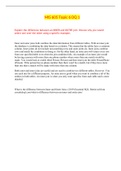
-
MIS 605 Topic 6 DQ 1 (Latest Update) Verified and Rated A+
- Exam (elaborations) • 1 pages • 2023
-
- $8.99
- + learn more
MIS 605 Topic 6 DQ 1 Explain the difference between an INNER and OUTER join. Discuss why you would select one over the other using a specific example. Inner and outer joins both combine the data/information from different tables. With an inner join the database is combining the data based on a relation. This means that the tables have a common column. Inner joints do not include non-matching rows and outer joints do. Inner joins combine rows and match the conditions in doing so. On the oth...
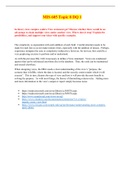
-
MIS 605 Topic 8 DQ 1 (Latest Update) Verified and Rated A+
- Exam (elaborations) • 1 pages • 2023
-
- $8.99
- + learn more
MIS 605 Topic 8 DQ 1 In theory, how complex could a View statement get? Discuss whether there would be an advantage to chain multiple views under another view. Where does it stop? Explain the possibilities, and support your ideas with specific examples. The complexity is exponential with each addition of each field. Careful attention needs to be made for each line so as not make minute errors, especially with the addition of aliases. Perhaps, experience mitigates the ease or complexity (...
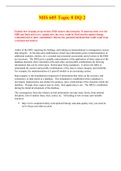
-
MIS 605 Topic 8 DQ 2 (Latest Update) Verified and Rated A+
- Exam (elaborations) • 1 pages • 2023
-
- $8.99
- + learn more
MIS 605 Topic 8 DQ 2 Explain how keeping an up-to-date ERD ensures data integrity. If someone looks over the ERD and finds and error, explain how the error could be fixed and the update/change communicated to other stakeholders. Discuss the potential backlash that could result from a misreported dataset. Audits of the ERD, reporting the findings, and making recommendations to management, ensure data integrity. As the data and combinations of deriving information grows (implementation of a...
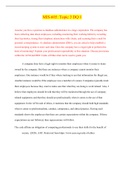
-
MIS-605: Topic 3 DQ 1 (Latest Update) Verified and Rated A+
- Exam (elaborations) • 2 pages • 2023
-
- $8.99
- + learn more
MIS-605: Topic 3 DQ 1 Assume you have a position as database administrator in a large corporation. The company has been collecting data about employees, including monitoring their working habits by recording their keystrokes, timing their telephone interactions with clients, and scanning their e-mail for personal correspondence. As database administrator (DBA), you are asked to help establish a record-keeping system to store such data. Does the company have a legal right to perform this kind ...

-
MIS-605: Topic 4 DQ 2 (Latest Update) Verified and Rated A+
- Exam (elaborations) • 2 pages • 2023
-
- $8.99
- + learn more
MIS-605: Topic 4 DQ 2 Your manager has difficulty understanding how SQL works and what insights the queries you have completed reveal. Discuss how you can communicate this information to the manager to get your point across. Provide specific ideas for ways to share the information in easy to understand terms. MIS-605: Topic 4 DQ 2 Your manager has difficulty understanding how SQL works and what insights the queries you have completed reveal. Discuss how you can communicat...
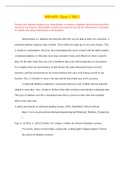
-
MIS-605: Topic 2 DQ 1 (Latest Update) Verified and Rated A+
- Exam (elaborations) • 2 pages • 2023
-
- $8.99
- + learn more
MIS-605: Topic 2 DQ 1 Explain why database designers use relationships to construct a database instead of listing all the records in one location. Some think it would seem easier to have all the information in one place, so explain why using relationships is the standard. Relationships is a database term that describes the way the data in tables are connected. A relational database organizes data in tables. These tables are made up of rows and columns. This is similar to a spreadsheet. Howe...
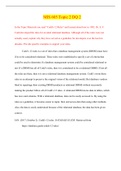
-
MIS 605 Topic 2 DQ 2 (Latest Update) Verified and Rated A+
- Exam (elaborations) • 1 pages • 2023
-
- $8.99
- + learn more
MIS 605 Topic 2 DQ 2 In the Topic Materials you read "Codd's 12 Rules" and learned about how in 1985, Dr. E. F. Codd developed the rules for an ideal relational database. Although all of the rules were not actually used, explain why they have served as a guideline for developers over the last few decades. Provide specific examples to support your ideas. Codd’s 12 rules is a set of rules that a database management system (DBSM) must have if its to be considered relational. These rules wer...
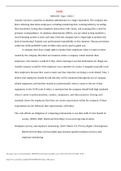
-
MIS-605: Topic 3 DQ 1
- Case • 1 pages • 2022
-
- $11.48
- + learn more
Assume you have a position as database administrator in a large corporation. The company has been collecting data about employees, including monitoring their working habits by recording their keystrokes, timing their telephone interactions with clients, and scanning their e-mail for personal correspondence. As database administrator (DBA), you are asked to help establish a record-keeping system to store such data. Does the company have a legal right to perform this kind of monitoring? Expla...
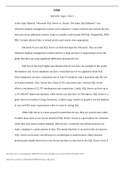
-
MIS-605: Topic 1 DQ 1
- Case • 2 pages • 2022
-
- $9.48
- + learn more
In the Topic Material "Microsoft SQL Server vs. Oracle: The Same, But Different?" two relational database management systems were compared. Conduct research and evaluate the pros and cons of two additional systems. Some to consider could include MYSQL, PostgreSQL, IBM DB2. Include relevant links to related articles and content when appropriate.
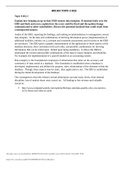
-
MIS 605 Topic 8 DQ 2
- Case • 1 pages • 2022
-
- $11.48
- + learn more
Topic 8 DQ 2 Explain how keeping an up-to-date ERD ensures data integrity. If someone looks over the ERD and finds and error, explain how the error could be fixed and the update/change communicated to other stakeholders. Discuss the potential backlash that could result from a misreported dataset.

Did you know that on average a seller on Stuvia earns $82 per month selling study resources? Hmm, hint, hint. Discover all about earning on Stuvia


